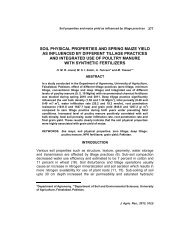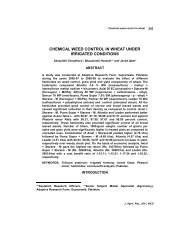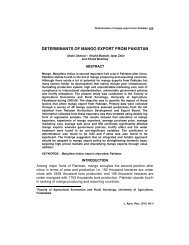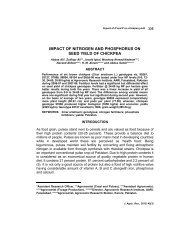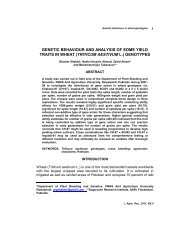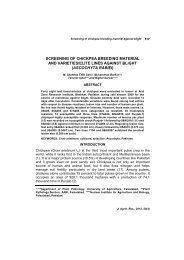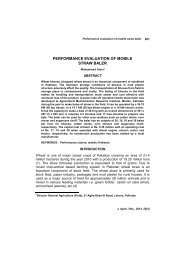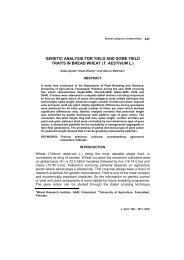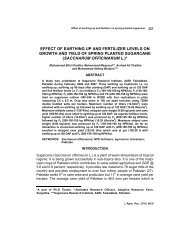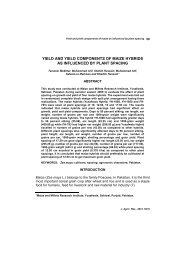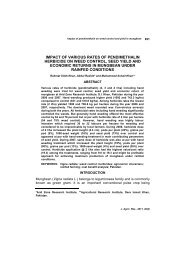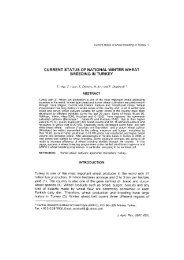Effect of varying Irrigation Frequencies on Growth, Yield and Quality ...
Effect of varying Irrigation Frequencies on Growth, Yield and Quality ...
Effect of varying Irrigation Frequencies on Growth, Yield and Quality ...
- No tags were found...
You also want an ePaper? Increase the reach of your titles
YUMPU automatically turns print PDFs into web optimized ePapers that Google loves.
<str<strong>on</strong>g>Effect</str<strong>on</strong>g> <str<strong>on</strong>g>of</str<strong>on</strong>g> irrigati<strong>on</strong> frequencies <strong>on</strong> pea<br />
343<br />
growth where water stress was avoided. The present results are also in line<br />
with those <str<strong>on</strong>g>of</str<strong>on</strong>g> Hsio et al. (13) who reported that water stress during growing<br />
stage reduced the growth <str<strong>on</strong>g>of</str<strong>on</strong>g> pea plants.<br />
Leaf area (cm 2 )<br />
Results <str<strong>on</strong>g>of</str<strong>on</strong>g> leaf area (cm 2 ) were found similar to those <str<strong>on</strong>g>of</str<strong>on</strong>g> number <str<strong>on</strong>g>of</str<strong>on</strong>g> leaves<br />
per plant. Maximum leaf area was observed in treatment I 3 in case <str<strong>on</strong>g>of</str<strong>on</strong>g> both<br />
cultivars. Meteor cultivar had comparatively more leaf area (246.0 cm 2 ) than<br />
Climax (241.0 cm 2 ) (Table 2). These results are similar to those <str<strong>on</strong>g>of</str<strong>on</strong>g> Hsio et al<br />
(13) who reported that water stress reduces growth via affecti<strong>on</strong> cell<br />
expansi<strong>on</strong>. In experiments with two pea cultivars, Salter (23, 24) also<br />
observed a resp<strong>on</strong>se to irrigati<strong>on</strong> at flowering but not to applicati<strong>on</strong> <str<strong>on</strong>g>of</str<strong>on</strong>g> water<br />
in dry c<strong>on</strong>diti<strong>on</strong>s during the vegetative growth stage.<br />
Number <str<strong>on</strong>g>of</str<strong>on</strong>g> pods per plant<br />
In this trait also both cultivars produced more number <str<strong>on</strong>g>of</str<strong>on</strong>g> pods per plant<br />
(Meteor 25 <strong>and</strong> Climax 22.3) in I 3 i.e. irrigati<strong>on</strong>s upto seed filling stage<br />
followed by I 4 i.e . irrigati<strong>on</strong>s upto seed maturity in case <str<strong>on</strong>g>of</str<strong>on</strong>g> Meteor (23.5) <strong>and</strong><br />
I 2 in case <str<strong>on</strong>g>of</str<strong>on</strong>g> Climax (21.5) (Table 3). For years effect, Climax gave more<br />
number <str<strong>on</strong>g>of</str<strong>on</strong>g> pods per plant during the year 2005-06 (22.1) than the year 2006-<br />
07 (19.8). However, Meteor produced similar number <str<strong>on</strong>g>of</str<strong>on</strong>g> pods during both<br />
years (22.7) which was higher than Climax.<br />
<str<strong>on</strong>g>Irrigati<strong>on</strong></str<strong>on</strong>g> upto flowering (I 1 ) produced the lowest number <str<strong>on</strong>g>of</str<strong>on</strong>g> pods (17.2)<br />
during the year 2006-07. <str<strong>on</strong>g>Irrigati<strong>on</strong></str<strong>on</strong>g> at any growth stage increased the yield <str<strong>on</strong>g>of</str<strong>on</strong>g><br />
Meteor. The highest yields for this cultivar were achieved where irrigati<strong>on</strong><br />
was applied throughout the seas<strong>on</strong> but these results did not differ<br />
significantly from other irrigati<strong>on</strong> treatments where less water was applied.<br />
There was also a more effect <str<strong>on</strong>g>of</str<strong>on</strong>g> irrigati<strong>on</strong> <strong>on</strong> Meteor cultivar than Climax. .<br />
As in the previous year, Meteor was also more resp<strong>on</strong>sive to irrigati<strong>on</strong> at<br />
vegetative stage than Climax <strong>and</strong> overall. In this experiment, water stress<br />
might have a str<strong>on</strong>ger effect <strong>on</strong> reducing the number <str<strong>on</strong>g>of</str<strong>on</strong>g> pods/unit area than<br />
<strong>on</strong> leaf area development. The low yields were associated with low number<br />
<str<strong>on</strong>g>of</str<strong>on</strong>g> pods, nodes/stem <strong>and</strong> pods/node <strong>and</strong> a slower increase in pod weight<br />
(19). Whether these changes would affect the balance between sources <strong>and</strong><br />
sinks, is uncertain. The resulting source-sink relati<strong>on</strong>ships during the filling<br />
phase would then have been quite different for early <strong>and</strong> late drought plots<br />
experienced. C<strong>on</strong>sequently, there may have surplus photosynthates to fill<br />
the peas in treatments with low pea numbers perunit area despite less<br />
J. Agric. Res., 2011, 49(3)



